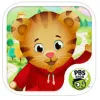Take a look inside 5 images
Daniel Tiger's Neighborhood: Play at Home with Daniel
Pros: Free exploration allows kids to be creative and fully in charge of their experience.
Cons: In terms of explicit learning content, there's very little here.
Bottom Line: Kids will enjoy exploring and playing, as well as talking with a grown-up about what they can learn.
Teachers can use these games as conversation starters about kids' own thoughts and experiences. For instance, kids can put Daniel to sleep and then talk about their own bedrooms or sleep routines. The music section has what might be the most classroom potential -- teachers can lead kids to explore different emotions, how they can be expressed, and how to manage them (like healthy ways to express anger). Kids can also practice reading emotions by asking what makes the music happy, sad, or angry. Since a lot of the learning potential relies on meaningful grown-up/child interactions, play might best be suited to small-group activities where kids can take turns exploring amidst meaningful discussion.
Daniel Tiger's Neighborhood invites kids to explore the different parts of his neighborhood. Kids can play "doctor" and learn about five commonly used tools in the doctor's office (pen light, tongue depressor, stethoscope, needle for shots, and otoscope). In the music section, they can create music with three different "moods" (happy, sad, and angry), each associated with a different kind of weather (sunny, rainy, stormy).
Kids can visit Daniel's bathroom where they interact with the sink, toilet, and a little toilet. In the sticker section, kids can choose from five backgrounds and add as many "stickers" as they like. Kids can save their creation by sending it to the device's camera roll. Finally, kids visit Daniel's bedroom, where they help him go to sleep by giving him a blanket and turning off the lights.
Daniel Tiger's Neighborhood allows kids to freely explore a variety of topics that, while they might seem random, are bound to be of interest to little ones. It's important to note that there isn't any actual learning content embedded in the app itself (aside from learning the names of a few doctor's tools). Therefore, playing these games will only be meaningful and instructive if a grown-up or teacher plays along with kids, using the games to start conversations.
While "playing doctor" might help familiarize kids with what's in a doctor's office, talking about the experience of visiting a doctor will make the learning come alive. The music section is fun and valuable for simple creation, but talking about emotional experiences (and how those can be reflected in weather, music) will really enhance what the app can teach. In fact, it would be nice if the app's information section included tips and guidelines for conversation and off-screen activities to make play a real learning experience.













